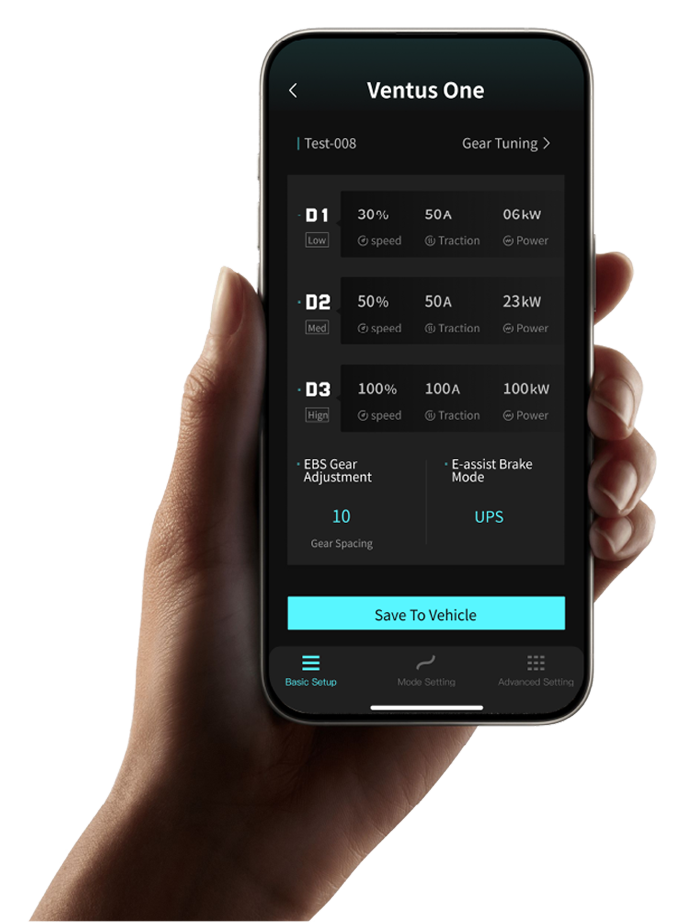You can access our controller modification manual at the following link:
-> Sur-Ron Light Bee User Modification Manual
-> Sur-Ron Ultra Bee User Modification Manual
-> E-ride PRO SS User Modification Manual
-> Talaria X3 User Modification Manual
-> Talaria Sting MX3&4&5 User Modification Manual
It’s located on the head tube, near the handlebars.
At 80V, fully charged with no load, the top speed is 153 km/h (approximately 130 km/h on the ground). At 70V, half-charged, the no-load speed is around 134 km/h (100 km/h on the ground). The actual range under mixed conditions is about 100 km. For slower, more economical riding, the range can extend to 120-150 km, but aggressive riding reduces it.
It’s designed for light off-road and trail use, though with tire swaps, you can use it on the track too. For road use, it cannot be street-legal without modifications.
The difference is significant. A higher voltage gives higher top speed and more power.
Power: The 50S has 28kW, while the 50G has 20kW.
In practice, there’s little difference below 50 km/h, but the 50S has better performance above that speed, especially on long uphill climbs.
Weight: The 50G is 200g lighter.
Lifespan: The 50G has a longer cycle life due to its focus on longevity.
Price: The 50G is better value for money.
Charging: The 50S charges faster (20% to 100% in about 50 minutes), while the 50G takes longer.
Regenerative Braking: The 50S has stronger electronic braking because of its higher charging current. However, the braking force of the 50G is weaker but still adequate for most situations.
Battery
Check the four corners of the battery for any gaps (if there’s a gap, it’s abnormal and needs to be sent back for repair). Also, the old model had a voltage meter, but we’ve upgraded to a new design.
Normally, batteries take years to show significant wear. Check if there are any fault alerts, if the tire setup has changed (off-road tires drain more power), or if there’s a potential issue with the battery’s health.
It’s best to recharge when the battery is below 30%, but don’t worry about fully charging it to 100%. Our system is designed to handle a full charge safely.
The 50G discharges at 270A, while the 50S discharges at 450A.
Max bus current: 500A/960A
Peak power: 44kW
Operating temperature range: -25°C to 80°C
Sine wave vector control
Voltage range: 30V-99V
Operating voltage: 48V-84V
We don’t use CAN bus; we use UART (serial communication).
We use a speed-based control model, not torque. Regen torque is dynamic and adjusts based on speed, so it isn’t constant. When braking, regen activates, regardless of throttle position.
This may be due to a blown fuse or controller failure. It’s rare, but we’ve redesigned the hardware to minimize issues. Please don’t worry; we’ll handle this with our after-sales support.
QS MOTOR QS-165:
Temperature sensor: NTC10k
Speed sensor: Encoder
Power-down temperature: 120°C
Power cutoff temperature: 140°C
First, check the sensor connections (Hall/encoder). Try re-learning the system or updating the firmware. Ensure that there is no water ingress or internal sensor failure.
Off-road motorcycles don’t typically state rated power since it depends on cooling. As a rough estimate, rated power is around half of peak power.
We don’t recommend setting the current this high, as it puts undue strain on the motor and controller. The default phase current is 550A, but it can be safely increased to 600-700A. Beyond that, you risk damaging the system.
Check the battery voltage settings in the advanced options. Ensure the full voltage doesn’t drop below the actual battery voltage. You can also check the throttle voltage by pressing the down button twice on the display.

Get ready to supercharge your ride with the VENTUS App! Track your bike in real-timelet instant safety alerts, and haveIl the control vou need riaht in your pockeNhether it’s scheduling repairs with a tap, tracking your epic journeys, or getting onhe-do cacnostics


